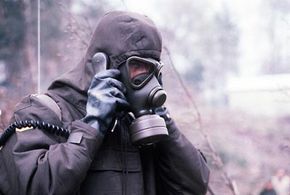Types of Gas Masks
When most people think about gas masks or respirators, what they usually envision is a tight-fitting plastic or rubber face mask with some sort of filter cartridge. The mask covers the nose and mouth. These are called half-mask air-purifying respirators. Depending on the chemical or biological agents in the environment, a half mask may not be sufficient because the eyes are very sensitive to chemicals and offer an easy entry point for bacteria. In this case, a full-face respirator is called for. It provides a clear face mask or clear eye pieces that protect the eyes as well.
Air-purifying respirators have two advantages:
Advertisement
- They are the least-expensive option.
- They are the least-complicated option.
The problem with air-purifying respirators is that any leak in the mask makes them ineffective. The leak could come from a poor fit between the mask and the user's face, or from a crack or hole somewhere on the mask.
Two other types of respirator systems solve the leak problem. The supplied-air respirator uses the same sort of filter cartridge found in an air-purifying respirator. However, instead of placing the filter directly on the mask and requiring the user's lungs to suck air through it, the filter attaches to a battery-operated canister. The canister uses a fan to force air through the filter, and then the purified air runs through a hose to the mask. The advantage is that the air coming into the mask has positive pressure. Any leak in the mask causes purified air from the canister to escape, rather than allowing contaminated air from the environment to enter. Obviously, positive pressure creates a much safer system, but it has two disadvantages:
- If the batteries die, so do you.
- The constant air flow through the filter means that the filter does not last as long.
However, for infants and children this may be the only option because their small faces make masks difficult to fit reliably.
The best system is called an SCBA (self-contained breathing apparatus) system. If you have ever seen a firefighter wearing a full-face mask with an air tank on his or her back, then you have seen an SCBA system. The air tank contains high-pressure purified air and is exactly like the tank used by a SCUBA diver. The tank provides constant positive pressure to the face mask. An SCBA provides the best protection, but has the following problems:
- The tanks are heavy and bulky.
- The tanks contain only 30 or 60 minutes of air.
- The tanks have to be refilled using special equipment.
- SCBA systems are expensive.
For firefighting, an SCBA system makes a lot of sense. The smoke is thick, dangerous and contains an unknown mix of poisonous gases. The fire may consume most or all of the oxygen in the air. The fire engine can carry extra tanks or refilling equipment, and a firefighter spends a limited time in the burning building. For civilians or for soldiers on the battlefield, however, an SCBA system is nearly impossible to manage because of the expense and the limited air time.
